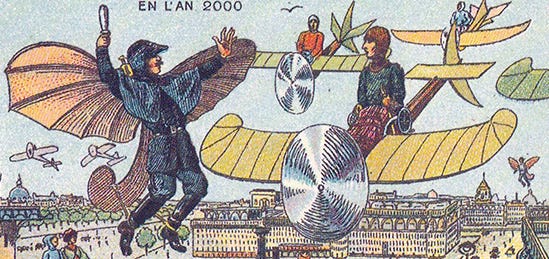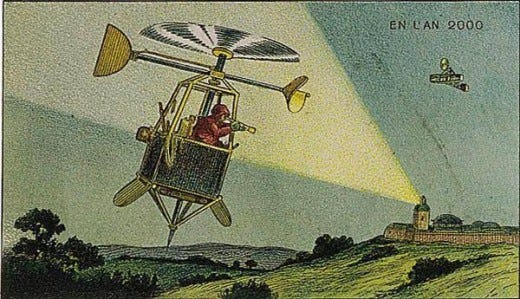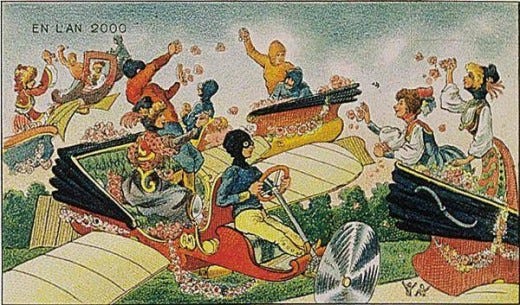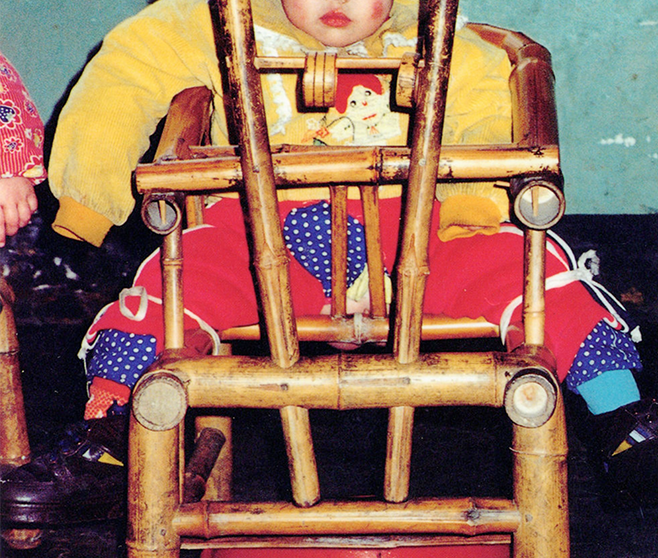The Myth of Overpopulation: A PsyOp to Kill the Future
We lost faith in human progress when we lost faith in humanity.
Grandma always liked to talk about that one fine day, back in 1929 …
It didn’t start out very well, she was doing a chore she hated, pumping water from the local well and carrying the heavy, unstable bucket back up a steep hill. Her home in suburban Ennis had indoor plumbing, why was their holiday cottage on the rugged Irish coast so far behind the times? She was grumbling to herself about this when she heard a motor.
Her heart skipped a beat – could it be one of those newfangled automobiles? She dumped the bucket and looked around, but she only saw cows and grassy fields. The sound wasn’t coming from the road. It was coming from the sky.
At the same time, Charles Lindbergh was sitting in a cramped position, holding his eyelids open with his fingers, struggling to stay awake, hoping against hope that he hadn’t flown The Spirit of St. Louis too far off-course. He was thrilled to see the craggy, west coast of Ireland. Despite his rudimentary navigation, he was ahead of schedule and only three miles off course.
He didn’t see Grandma, of course, but she saw him, and she knew what that plane meant. She was seeing the future — and it would be grand!
She was right. Despite events that threatened to end her world; the tragic civil war that followed the Irish War of Independence, leaving home to cross the Atlantic, WWII, dealing with nasty Bronx landlords, she stayed optimistic about the future, for herself, her children, her grandchildren and her great-grandchildren.
And she lived to see it all — medical advances extended her life and saved her eyesight. Her walkup apartment was warm in the winter and cool in the summer. And she had all the running water she could drink.
In the early twentieth century, most people thought technology would bring a better life. To capture that spirit of hope, Jean-Marc Côté and other French artists created postcard visions of life in the year 2000.
In those days, most people could only expect to live to be 50 or so. Economies were uncertain. Recessions were frequent. But they believed human ingenuity would make the future easier, faster and –fun.
Of these postcards, ‘The Nature of the Beast’ says:
”Here are some illustrations of what people in 1910 envisioned the year 2000 to be. These illustrations demonstrate a world where technology is an extension of the physical self, technology is used to enhance everyday life and people can do things easier and faster. I find this interesting as most visions of the future tend to focus on the concept of technology as a threat to humanity”
This is sad but true. Despite huge increases in the average lifespan, great advances in medicine, communications and transportation, many people nowadays think technology is a threat, not a benefit. Many have a dour view of humanity’s future with or without technical advances. Some see humanity as a virus that the world would be better off without.
When did our visions of a better future go from easy, fast and fun technology …
To apocalypse?
The Great Depression gave us plenty to be pessimistic about, but during the 1930’s, our visions of the future remained sunny. The popular 1933-34 World’s Fair promised a happier not-too-distant future driven by innovation; automobiles, architecture and even cigarette-smoking robots. Most people just knew things would improve (even if those improvements might be kind of weird).
Totalitarian regimes lured followers with the promise of a better future. But even after those futuristic dreams failed and the world witnessed the horrors of WWII, people still believed in progress.
In his essay “We Need a New Philosophy of Progress”, Jason Crawford says:
“In the 1950s and ‘60s, people looked forward to a future of cheap, abundant energy provided by nuclear power; Isaac Asimov even predicted that by 2014, appliances “will have no electric cords, of course, for they will be powered by long-lived batteries running on radioisotopes.” A 1959 ad in the Los Angeles Times sponsored by a coalition of power companies referred to “tomorrow’s higher standard of living”—without explanation, as a matter of course—and illustrated the possibilities with a drawing of a flying car.”
In the 1950’s and early ’60s, we thought space would be our future. The government spent millions planning Project Horizon, a scientific/military based moon habitat. George Jetson had his flying car. Even the grimmest predictions of life in the twenty-first century assumed a human presence in space.
But things changed around the mid-60’s. That era became a “boom time” for nightmarish visions of our future. In his 2015 NY Times article “The Unrealized Horrors of Population Explosion”, Clyde Haberman says:
“In 1966 .. a writer named Harry Harrison came out with a science fiction novel titled “Make Room! Make Room!” Sketching a dystopian world in which too many people scrambled for too few resources, the book became the basis for a 1973 film about a hellish future, “Soylent Green.” In 1969, the pop duo Zager and Evans reached the top of the charts with a number called “In the Year 2525,” which postulated that humans were on a clear path to doom.”
The threat of nuclear war was not enough to cause widespread fear of our tech and our future. But one PsyOp, (defined as an operation to convey selected information and indicators to audiences to influence their emotions, motives, and objective reasoning, and ultimately the behavior) — did.
Hugh Moore, an advertising guru and founder of the Dixie Cup Company, became convinced that population growth would lead to the spread of communism. He believed the way to stop this was to convince communist leader that their population, their greatest strength, was their greatest weakness.
Salesmanship is the art of polishing a turd. Marketing expert Moore was inspired by another turd polisher, British Economist Thomas Robert Malthus.
In 1798, Malthus published An Essay on the Principle of Population, which claimed that “population growth always outstrips our ability to supply the concurrent need for increased resources (especially food), resulting in inevitable cycles of overpopulation, rapid resource depletion, and extreme human suffering.”
Malthus saw humanity as a consumption machine, a dumb herd of animals that would strip one field bare, then move on to the next one. He believed it was better to prevent the overpopulation catastrophe proactively, by “permitting” higher mortality rates. Basically, catastrophic tyranny and deprivation would be necessary to prevent catastrophic tyranny and deprivation.
This circular reasoning led to the starvation of millions in India and Ireland during the late 1800’s. It went on to inspire the founder of eugenics, Sir Francis Galton . And, of course, it was the inspiration for Hitler’s atrocities.
After Hitler, Malthus and his Eugenics needed rebranding. Enter the turd-polisher, Moore.
As Robert Zubrin says in “The Population Control Holocaust”
“Until the mid-1960s, American population control programs, both at home and abroad, were largely funded and implemented by private organizations such as the Population Council and Planned Parenthood — groups with deep roots in the eugenics movement. While disposing of millions of dollars provided to them by the Rockefeller, Ford, and Milbank Foundations, among others, the resources available to support their work were meager in comparison with their vast ambitions. This situation changed radically in the mid-1960s, when the U.S. Congress, responding to the agitation of overpopulation ideologues, finally appropriated federal funds to underwrite first domestic and then foreign population control programs. Suddenly, instead of mere millions, there were hundreds of millions and eventually billions of dollars available to fund global campaigns of mass abortion and forced sterilization. The result would be human catastrophe on a worldwide scale…
…President Lyndon Johnson was provided a fraudulent study by a RAND Corporation economist that used cooked calculations to “prove” that Third World children actually had negative economic value. Thus, by allowing excessive numbers of children to be born, Asian, African, and Latin American governments were deepening the poverty of their populations, while multiplying the masses of angry proletarians ready to be led against America by the organizers of the coming World Revolution.
An Office of Population was set up within USAID, and Dr. Reimert Thorolf Ravenholt was appointed its first director in 1966. He would hold the post until 1979, using it to create a global empire of interlocking population control organizations operating with billion-dollar budgets to suppress the existence of people considered undesirable by the U.S. Department of State.”
With the US government’s financial incentives in place, ‘Population Control’ became driving force.
In the late 1970’s, family planning became essential to “China’s socialist modernization.” Under their One Child Policy, all women with one child were ordered to have a stainless-steel IUD inserted. Removing it was crime. All parents with two or more children were to be sterilized. No pregnancies for anyone under 23. All unauthorized pregnancies were to be aborted through the ninth month of pregnancy. Many cried as they were being stabbed to death at the moment of birth. Women who fled to save their children were hunted. If they could not be caught, their houses were torn down and their parents thrown in prison. If those babies survived, they became “black children,” non-persons without any right to employment, public schooling, health care, or reproduction.
Dr. Ravenholt, an epidemiologist who apparently saw pregnancy as “a disease, to be eradicated in the same way one eliminates smallpox or yellow fever.” thought this was a success.
The leaders of the UNFPA and the International Planned Parenthood Federation also thought it was a success. But Planned Parenthood’s information officer, Penny Kane, worried that, if the news of this got out, the public-relations disaster could harm Planned Parenthood’s image in the USA.
”Shown above is Mei Ming, a two-year-old girl tied to a chair in a “dying room.” The bucket below her is to catch her urine and feces as she dies over the next several days from starvation and neglect. The above photo was taken by a British TV crew during their filming of the 1995 documentary exposé The Dying Rooms. The Chinese government denies the existence of dying rooms.”
— Courtesy Care of China’s Orphaned and Abandoned
The story of how girls like Mei Ming were killed did reach the western media, but by that point, the Myth of Overpopulation had become so pervasive, it barely made a dent in the national consciousness.
The horror of these still haven’t made much of an impression on true believers. One commenter on the article “The Unrealized Horrors of Population Explosion” praised China’s one child policy for “greatly reducing the current and future population surplus that China will have to provide for. And, given that China is by far the most populated country in the world, their contribution to the reduction in growth is the dominant one.”
In 2015, 27 New York Times readers were enthusiastic about a comment praising the ‘abhorrent’ yet effective slow starvation of thousands of babies.
In 1968, ecologist Paul Ehrlich published “The Population Bomb”. He stole the title from an earlier pamphlet written by Moore, who was happy to lend his support. David Brower, executive director of the Sierra Club, supported “Bomb”, as well. He hoped it would influence the 1968 presidential election.
The first sentence of Ehrlich’s book set the tone: “The battle to feed all of humanity is over… hundreds of millions of people are going to starve to death.” Like Malthus, Ehrlich had no faith in humanity’s ability to adapt or innovate. Like sheep, we could do nothing to “prevent a substantial increase in the world death rate.” The only solution was to reduce our numbers or face “mass starvation” on “a dying planet.”
Like Malthus, Ehrlich’s predictions were consistently wrong but like any cult leader, he kept moving the doomsday date back. And, like any salesman/turd polisher, he changed the label. The overpopulation crisis slowly morphed into a Climate crisis that, once again, would require us to reduce our numbers, destroy our food sources and cripple our economies . The option of using low-emission nuclear power to solve climate issues was dismissed by Ehrlich, who wrote that “giving cheap, abundant energy to humanity would be like ”giving an idiot child a machine gun”
Of course, Ehrlich and his followers did not think that they were ‘idiot children’. Those ICs were the unwashed masses who did not attend the right cocktail parties or appear on Johnny Carson. Of the racism and classism inherent in our ‘fight’ against overpopulation, Brittney Bush Bollay, Seattle Group Sierra Club Chair said:
“In fact, the very roots of the modern population control movement are racist. Commonly traced back to the 1968 book “The Population Bomb,” which opens its fear-mongering with a sensationalized account of traveling through Delhi, India. During a taxi ride, author Paul Ehrlich describes “People visiting, arguing and screaming. People thrusting their hands through the taxi window begging… Since that night I’ve known the feel of overpopulation.” What Ehrlich fails to mention, however, is that, while Delhi’s population was just shy of three million, both New York and Paris housed about eight million at the time. Ehrlich’s emphasis on an Indian city as the exemplification of overpopulation was part of a large and continuing pattern of focusing blame on the global south and the mostly non-white people who live there by affluent Western Europeans and Americans.
Sierra Club must reckon with its own role in this history. Our complicity is inescapable: the Club was heavily involved in the initial publishing of Ehrlich’s book, and for many years supported its ideas. As recently as 2004, xenophobic factions attempted to enact an anti-immigration agenda by trotting out the overpopulation bogeyman. Above all, we must understand that employing this type of rhetoric often leads to tragic consequences.”
Sir David Attenborough claims the world’s rising human population must be brought under control for the quality of life — of other animals. Speaking on BBC Radio 5 live’s Breakfast, he said: “There are areas of the world that are still unspoilt [by humans] .. but that may not be the case if in fact our numbers go on increasing at the present rate.””
It’s strange for a naturalist to be so clueless about nature. A successful species always tries to increase their numbers, to grow and thrive. An unsuccessful one doesn’t. Failure to grow is — failure. No species has ever collectively said, ‘hey, let’s take it down a few notches, let’s stop having kids and searching for new food sources.’
If they did, no trace of them remains.
I love the Sierra Club’s gorgeous calendars, and I love Attenborough’s nature shows. But I know those cute and pretty pictures are coercing consent for genuinely harmful policies that are based on a profound fear of natural adaptation and change.
This fear of change is perfectly expressed in the dream of ‘Spaceship Earth’, the Utopian belief that Earth can be managed at an optimum homeostasis (planetary equilibrium), perfect and unchanging, like a terrarium in a jar .
Pensioner David Latimer from Cranleigh, Surrey, with his bottle garden — The Daily Mail
Unfortunately, this Utopian experiment was already tried. It failed, miserably.
In 1947, Baltimore biologist John Calhoun was studying the behavior of the Norway rats who plagued his city. He built a quarter-acre rat Utopia behind his house, filled it with breeding pairs and constantly catered to all their needs. He hoped to house 5,000 rats there, but the population never exceeded 150. At that point, his pampered rats fell into a weird and then alarming orgy of self-destruction.
Calhoun couldn’t figure out why his rats, who had everything they needed, failed to thrive, while wild and free rats were taking over Baltimore.
So he built another, slightly bigger Utopia. It failed. He built another and another. They all failed. In the same way. So he gave up on trying to understand wild rats via his rat Utopia and began to frame his work in terms of population: How many individuals could a rodent city hold without losing its collective mind? The National Institute of Mental Health gave him more money for more “rodentopias.”
All of the Utopias collapsed, each according to the same pattern:
Early success: pups are born. The population doubled every two months—20 rodents, then 40, then 80. Families became dynasties, holding down the best real estate.
Plateau – When more young survived to maturity than were necessary to replace the dying or senescent, the downfall began. New generations couldn’t find enough mates & a places in the social order. Males who failed withdrew physically and psychologically; they weren’t attacked by territorial males, but they attacked each other. Withdrawn females also isolated. Solitary males & females preened themselves, becoming the “beautiful ones”.
Downfall – Aggressive mice attacked others for no real motivation or gain. Rape and cannibalism became rampant. Overextended parents moved nests constantly to avoid the gangs and took their stress out on their babies, kicking them out of the nest too early and losing them during moves. Infant mortality in some territories of the utopia reached 90 percent.
Behavioral sink – The mice who managed to survive this enclosed utopia never learned how to be — mice. Adolescents literally forgot how to mate. The violent males became more powerful. The combination of mad violence and senescence led to the inevitable apocalypse, despite the fact that their basic needs were still being met.
In 1972, Calhoun wrote about his biggest failed Utopia, Universe 25. At first, he blamed overpopulation for the failure. In the late sixties and early seventies, this made the story of Universe 25 an instant hit. Senators quoted him, creators of doom and gloom sci-fi stories were inspired. Here was proof that the Malthusians were right.
But they missed the point of Calhoun’s research. His original goal was to understand why rodents thrived in the hard-knock streets and sewers of Baltimore but failed miserably in his enclosed Utopia.
That question was answered when he wrote.
“In the normal course of events in a natural ecological setting somewhat more young survive to maturity than are necessary to replace their dying or senescent established associates. The excess that find no social niches emigrate.”
The “excess” could not move on to find new horizons because there was nowhere else to go. His Utopia didn’t prove that population growth and change would lead to our destruction, it proved the opposite. The wild rats and mice were his control group. They survived and thrived because they kept adapting, expanding and growing. His pampered mice died because they could not leave their enclosed ‘paradise’.
As the Malthusians are so fond of pointing out, humans are just another animal. Freedom, exploration and growth are not a luxury for animals, they’re like food and air, essential to survival. Nature abhors a Utopia in the same way it abhors a vacuum.
If the dream of ‘Spaceship Earth’ came true, it would be our tomb.
Evidence has never been on the Malthusians side. History shows that freedom leads to a world of innovation and prosperity that Grandma never dreamed of.
But it’s hard to reason people out of something they were never reasoned into. Like Calhoun’s rodents, Malthusians are perpetually trapped in their closed mind-space, their contempt for progress, humanity, art and ‘freedumbs’.
Even John Lennon couldn’t convince them when he said, back in 1971 “I think it’s really a joke .. they way people have made this over-population thing … I don’t really believe it… whatever happens will balance itself out…It’s alright for us all living to say, ‘Well, there’s enough of us [people] so we won’t have any more…I think we have enough food and money to feed everyone .. and some can go to the moon ..”
He went on to say it was a myth that was meant to distract us from Vietnam and Ireland. Dick Cavett said. “I think you’re wrong about that.”
And Lennon said “Oh, well I don’t care.”
Lennon was right. The Malthusians’ myth is corrosive to our belief in ourselves and our future. There is no reason to vote for them or to care about their advice. They do not have our best interests at heart.















I love this article. Thank you. I often say that the malaise of modern needs-already-met society is wrapped up perfectly by the early-70s sentiment "If we can put a man on the moon, why can't we solve world poverty?" You've given me more perspective on that, plus fabulous pictures. Yoink!